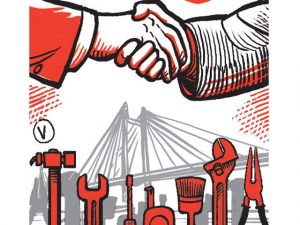
28-10-2016 (Important News Clippings)
To Download Click Here
DND toll verdict
Poor contracts in PPP will not stand

The contract with private developer NTBCL was awarded without competition, guaranteed a 20% return on investment for 30 years, stipulated that tolls would go up in line with inflation and added shortfalls in this regard to the project cost on which returns are guaranteed. The company was to be compensated with land for development, in lieu of shortfalls to the guaranteed return. NTBCL’s concession agreement executed with New Okhla Industrial Development Authority is a poor example of PPP in infrastructure. NTBCL has reportedly realised the construction cost of the flyway several times over. Rightly, the Allahabad High Court said the levy of the toll is unjust and unfair and that the method of calculating the total project cost of the expressway was arbitrary and against public policy. NTBCL has moved the Supreme Court to challenge the court’s order, paving the way for a legal battle that we hope will transfer the toll road to the state soon.India needs more roads and infrastructure to be built and paid for through PPP. Private builders of such projects have to make decent returns on the capital employed. So, the need is for better contracting and transparency in the award of the contract, and flexibility in the time of operation, after building the asset, before transfer to the state.
मध्यस्थता की महत्त्वाकांक्षा
प्रधानमंत्री नरेंद्र मोदी ने देश को अंतरराष्ट्रीय कारोबारी विवादों के निस्तारण में मध्यस्थता का वैश्विक केंद्र बनाने की बात कही है जो बहुत सराहनीय है। सोच के स्तर पर यह विचार बढिय़ा है लेकिन इसका क्रियान्वयन उतना ही महत्त्वाकांक्षी। मोदी ने कहा कि भारत में बढिय़ा मानव संसाधन है और वह किफायती भी है। उन्होंने प्रक्रियाओं को समय पर पूरा करने और पेशेवर आचरण को अंतरराष्ट्रीय मामलों के निस्तारण के लिए अतिरिक्त खूबी बताया। बहरहाल प्रधानमंत्री यह सब कहते हुए शायद कुछ ज्यादा ही उदारता बरत गए। शायद मोदी का आत्मविश्वास इस बात से बढ़ा है कि सरकार ने बीते वर्ष देश में मध्यस्थता का कायदा सुधारने की दिशा में एक अहम कदम उठाया। दरअसल 23 अक्टूबर, 2015 को सरकार ने पंचाट एवं सुलह (संशोधन) अधिनियम को सैद्घांतिक मंजूरी दे दी।
Running to stand still
As proof of its commitment to economic renewal, the Narendra Modi government had set itself the target of breaking into the top 50 in the World Bank’s annual ranking of countries on ease of starting and operating a for-profit enterprise. That the Bank in its Doing Business 2017 report now ranks India 130 among 190 countries, just one notch higher than last year, is therefore likely to be taken as a signal of the snail’s pace of economic reform. This too when competition is hotting up. Seventy-five per cent of the 283 reforms reported this year were carried out by the developing economies, and the world’s ten best improvers include Pakistan, Kazakhstan, Serbia, Kenya and Indonesia. The report notes that the BJP-led government was elected in 2014 “on a platform of increasing job creation, mostly through encouraging investment in the manufacturing sector.” While it has left out labour regulations from this year’s index, the Bank acknowledges India’s gains in simplifying tax payments, trade procedures and contract enforcement (though it still ranks a low 172 on this front). Most heartening is that India is now the 26th easiest place to get an electricity connection, up 25 places from last year. The average time taken to get a connection has come down from 138 days in 2013-14 to 45 days in 2015-16. Besides, transformative changes such as the proposed Goods and Services Tax and insolvency and bankruptcy norms, if implemented by June next year, could propel India higher in the Bank’s next report.
हिंदुत्व पर विचार नहीं
सवरेच्च न्यायालय के यह कहने के बाद कि उनके समक्ष हिंदुत्व का मसला विचाराधीन नहीं है और इस पर वह विचार नहीं कर रहा है, इस संबंध में पैदा हुई गलतफहमी दूर हो जानी चाहिए। वास्तव में यह गलतफहमी याचिकाकर्ता तीस्ता शीतलवाड़ और उनके समर्थकों द्वारा फैलाई गई थी कि उन्होंने 1995 में सर्वोच्च न्यायालय द्वारा हिंदुत्व के मामले पर दिए गए फैसले के संदर्भ में पुनर्विचार याचिका डाली है, जिसे न्यायालय ने स्वीकृत कर लिया है। यह बात ठीक है कि तीस्ता ने न्यायालय से मांग की कि चुनाव में दलों को ‘‘हिंदुत्व’ के नाम पर वोट मांगने से रोका जाए, और इसे न्यायालय ने स्वीकार कर लिया। इस पर सुनवाई चल रही है। किंतु इसका अर्थ न्यायालय की नजर में यह नहीं है कि उसे 1995 के उस ऐतिहासिक फैसले पर पुनर्विचार करना है, जिसमें हिंदुत्व को एक मजहब या पंथ के बजाय जीवन दर्शन माना गया था। न्यायालय ने स्पष्ट किया है कि उसके सामने जो मामला विचार के लिए है, वह जनप्रतिनिधित्व कानून की धारा 123(3) की व्याख्या का है। दरअसल, 1995 में हिंदुत्व के नाम पर वोट मांगने के आधार पर बंबई हाई कोर्ट ने भ्रष्ट तरीका मानते हुए करीब दस नेताओं के चुनाव रद्द कर दिये थे। हालांकि 1995 में सर्वोच्च न्यायालय ने यह फैसला पलट दिया था। उसी फैसले में तीन न्यायाधीशों की पीठ ने हिंदुत्व को धर्म के बजाय जीवनशैली कहा था। इन्हीं मामलों से संबंधित कई याचिकाएं लंबित रह गई थीं। इन सबमें धर्म के आधार पर वोट मांगने का ही मसला शामिल है, जो कि तीन फिर पांच न्यायाधीशों की पीठ से होता हुआ सात न्यायाधीशों की पीठ तक पहुंचा है। हम मानते हैं कि धर्म, जाति, नस्ल, पंथ, संप्रदाय, क्षेत्र या भाषा किसी के नाम पर वोट मांगना चुनाव के भ्रष्ट तरीकों में शामिल है और ऐसा करने वालों का चुनाव रद्द होना चाहिए। किंतु कोई व्यक्ति धार्मिंक है, अपने भाषण में धर्म का कोई उदाहरण देता है, जिसमें उसका उद्देश्य यह नहीं है कि लोग उसे फलां धर्म का मानकर वोट करें तो यह भ्रष्ट आचरण में नहीं आ सकता। न्यायालय इस पर अपना मत साफ प्रकट कर दे कि अगर हिंदुत्व जीवन शैली है तो उसका चुनाव में उपयोग होना चाहिए या नहीं और होना चाहिए तो किस सीमा तक।
Like advanced nations, India must delink classroom teaching from student learning
The objective is not to teach to the student, which happens through classroom contact, but to make the student learn, which can happen outside classroom contact too.

The refrain is indeed true. Several ingredients result in the outcome the refrain describes, beginning with entry into the education stream at the pre-school level. Let me focus on only one element of that maze — higher education, and within that, on one small aspect. How many hours per week, on average, does a student spend in attending lectures? The answer will be a function of country, course and level of higher education.
In general, in the US and Western Europe, I suspect the answer is about 15 hours. The catch lies in the expression “attending lectures”, there being a difference between learning hours and classroom hours. The objective is not to teach to the student, which happens through classroom contact, but to make the student learn, which can happen outside classroom contact too. Indeed, the norm in those countries seems to be that for every one hour spent through didactic teaching and classroom contact, the student spends two hours on learning indirectly — 15 hours of classroom teaching thus translates into 45 hours of weekly learning.In 2015, the UGC announced a choice-based credit system. Though this made higher education options more flexible, it was controversial because of other reasons. This new system has the following definition. “Credit: A unit by which the course work is measured. It determines the number of hours of instruction required per week. One credit is equivalent to one hour of teaching (lecture or tutorial) or two hours of practical work/field work per week.” Credits earned by a student per semester are a summation of lecture plus tutorial plus practical work.
Unless I’ve misunderstood, practical work/field work is meant for science subjects. For social sciences, student learning is still equated with contact with a teacher, albeit lectures plus tutorials. I asked some students of Delhi University about the number of hours of lectures they have per week. I was told, around 28 hours of lectures per week and around 40 hours, inclusive of tutorials and practical work. (Lectures are typically 55 minutes duration, not one hour; I’ve glossed over that minor difference). I suspect 40-45 hours will be the norm throughout much of India. This means either (a) a student has no time to learn on his/her own; or (b) the student spends 120 hours (using that additional multiple of two times) per week on learning.Since there are only 168 hours in a week, that extreme of 120 hours is impossible. Something like 80 hours is more plausible. The Factories Act (applies to those more than 18) tells us no one should work more than 48 hours a week. Why should that principle not apply to students? Why must we turn them (those who slog for 80 hours) into zombies? The norm will be the student who does not learn on his/her own and therefore, never thinks. If it is (a), the student will invariably reproduce by rote. Therefore, my first proposition is of delinking classroom teaching from student learning, a distinction advanced countries have now accepted. Fifteen hours of classroom teaching is good enough. The second proposition is a stronger one.
What has teacher input got to do with the outcome of student learning? In other spheres, we appreciate the difference between input and outcomes. Why not for higher education? That norm of 40 hours of lectures per week emanates from indicative workloads laid down for teachers. There is a marginal difference between assistant professors, associate professors and professors. Roughly, they have to teach for 15 hours a week. Add an additional 30 hours of tutorials and we have 45 hours. Tutorials also involve physical interface with the teacher. They don’t constitute independent student learning.
Paraphrased, students have 40 (or 45) hours of lectures a week because teachers have to “teach” for 45 hours a week. In the US, credits have their origins in Carnegie Units, pioneered by Carnegie Foundation to determine retirement pensions for professors. At roughly the same time, in 1872, Morris Lyewellyn Cooke wrote a report for Carnegie Foundation for the Advancement of Teaching. This was titled Academic and Industrial Efficiency. The intention was to standardise faculty workloads and use this as a measure of delivery of education. There are obvious parallels with factories and industrial production, a bit like Ford Motor Company using mass production to manufacture Model T cars: “Any customer can have a car painted any colour that he wants so long as it is black.”But higher education isn’t factory production, or shouldn’t be. To quote Henry Ford again, “I will build a car for the great multitude. It will be large enough for the family, but small enough for the individual… But it will be so low in price that no man making a good salary will be unable to own one.” Other countries (read Standards and Guidelines for Quality Assurance in the European Higher Education Area 2015) have moved away from such dysfunctional ideas. So should we.
Bibek Debroy The author is member, NITI Aayog.
कारोबार की बाधाएं
जरूरत भी पुरानी है और सपना भी। पिछले कई साल से देश के आर्थिक नियोजन के पीछे काम करने वाला विचार यही रहा है कि दुनिया भर के निवेशक, बड़ी-बड़ी कंपनियां भारत में पैसा लगाएं, यहां अपनी उत्पादन इकाइयां खोलें, तो इससे एक तो लोगों को रोजगार मिलेगा और दूसरे देश की खुशहाली का रास्ता भी तैयार होगा। कुछ हद तक ऐसा हुआ भी है, लेकिन देश में जितनी बड़ी बेरोजगार सेना है, जितनी देश के नौजवानों की संख्या है और जितना बड़ा इस देश का कुलजमा बाजार है, उसे देखते हुए यह बहुत ज्यादा नहीं है। अगर हम पड़ोसी चीन से तुलना करें, तो भारत विदेशी निवेशकों और कंपनियों को आकर्षित करने में बहुत पीछे है। यहां तक कि दुनिया के बहुत छोटे देश भी इस कतार में हमसे बहुत आगे हैं। ऐसा क्यों होता है कि किसी एक देश में निवेशक खिंचे चले आते हैं और एक के बाद एक उत्पादन इकाइयां लग जाती हैं, लेकिन कुछ दूसरे देश सिर्फ ताकते रह जाते हैं?निवेशक यह देखते हैं कि किस देश में कारोबार करने का माहौल कितना अच्छा है? जिस देश में जितना अच्छा माहौल होगा, उस देश में वे कारोबार करने को उतनी ही जल्दी तैयार हो जाएंगे। किस देश में कारोबार का माहौल कितना अच्छा है, इसे जानने के लिए विश्व बैंक ने एक सूचकांक तैयार किया है, जिसे ‘ईज ऑफ डूइंग बिजनेस’ यानी कारोबार में आसानी सूचकांक कहते हैं। साल 2003 से शुरू हुए इस सालाना सूचकांक में भारत इस समय 130वें स्थान पर है। यानी अगर कोई निवेशक सिर्फ कारोबार में आसानी के लिहाज से सोचे, तो भारत में निवेश की बात सोचने से पहले वह 129 देशों के नाम पर विचार कर चुका होगा।
यहां भारत का 130वें स्थान पर आना खबर नहीं है, क्योंकि इस सूचकांक में भारत हमेशा से ही फिसड्डी रहा है। खबर यह है कि इस मामले में भारत में जितने सुधार होने चाहिए थे, वे नहीं हुए हैं। भारत की प्रगति कितनी धीमी है, इसका अंदाज इसी बात से लग सकता है कि पिछले साल भारत 131वें स्थान पर था और उसके पहले 134वें स्थान पर, जबकि इसी दौरान एक धारणा यह बनी थी कि तेज आर्थिक और प्रशासनिक सुधारों की वजह से भारत में कारोबार करना लगातार आसान होता जा रहा है।अगर इस सूचकांक की और गहराई में जाएं, तो नई परियोजना के लिए विद्युत कनेक्शन लेने जैसी जरूरतों के मामले में काफी सुधार हुआ है, लेकिन कुछ और जरूरी चीजों के मामले में स्थिति पहले के मुकाबले बिगड़ी है। दिक्कत यह है कि इस सूचकांक में भारत ब्रिक्स देशों में सबसे पीछे तो है ही, नेपाल और श्रीलंका जैसे पड़ोसी देश भी उससे बहुत आगे हैं। हालांकि, सच यह है कि न सिर्फ भारत का बाजार बहुत बड़ा है, बल्कि यहां कुशल और अकुशल श्रमिकों की संख्या भी काफी ज्यादा है।
कारोबार में आसानी का यह सूचकांक सिर्फ अर्थव्यवस्था या आर्थिक नीतियों का मामला नहीं है, यह दरअसल हमारी नौकरशाही और हमारी राजनीति की कहानी कहता है। इन्हीं दोनों की वजह से देश में न सिर्फ कारोबार करना कठिन है, बल्कि आम नागरिक जीवन भी बहुत कठिन है। कदम-कदम पर बाधाएं खड़ी करना, उन बदलावों को रोके रखना, जो समय की मांग हैं, यह सब चीजें कारोबारियों के लिए ही नहीं, आम लोगों के लिए भी समस्याएं खड़ी करती हैं। आमतौर पर हम मान लेते हैं कि आर्थिक नीतियां बदलने से ज्यादा निवेश आएगा और विकास दर बढ़ेगी, जबकि सच यह है कि भारत जैसे देश में विकास दर को इससे कहीं ज्यादा सिर्फ प्रशासनिक और न्यायिक सुधार करके बढ़ाया जा सकता है।


